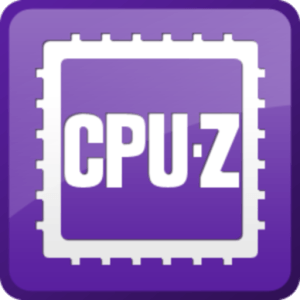CPU-Z is a freeware utility that has been round for over 20 years. Fashionable CPUs include a set of directions, that when activated, present a wealth of details about the processor: model, mannequin, variety of cores, cache ranges, and so forth. Along with the brains of the pc, it additionally shows related details about the motherboard and system reminiscence, together with:
- Processor title and quantity, codename, course of, bundle, cache ranges
- Mainboard and chipset
- Reminiscence sort, measurement, timings, and module specs (SPD)
- Actual time measurement of every core’s inner frequency, reminiscence frequency
CPU-Z additionally accommodates a easy CPU benchmark and stress check; you may add your outcomes onto their web site and share your statistics.
The Android model of CPU-Z reviews details about your cellular units:
- SoC (System on a Chip) title, structure, clock pace for every core
- System info : system model & mannequin, display decision, RAM, storage.
- Battery info : degree, standing, temperature, capability
- Sensors
CPU
- Identify and quantity
- Core stepping and course of
- Bundle
- Core voltage
- Inside and exterior clocks, clock multiplier
- Supported instruction units
- Cache info
Mainboard
- Vendor, mannequin and revision
- BIOS mannequin and date
- Chipset (northbridge and southbridge) and sensor
- Graphic interface
Reminiscence
- Frequency and timings
- Module(s) specification utilizing SPD (Serial Presence Detect) : vendor, serial quantity, timings desk
System
- Home windows and DirectX model
Why is CPU-Z so widespread?
CPU-Z is widespread amongst PC fans because it affords updated, detailed, and correct knowledge in regards to the {hardware} present in your pc. CPU-Z is a comparatively easy utility that does effectively what it is speculated to do.
What’s one favourite CPU-Z characteristic?
CPU-Z affords a {hardware} validation characteristic. With only a click on you’ll obtain a hyperlink with all of your system specs which you can share with others. You need to use this report to point out proof of your {hardware} and its capabilities, or simply as a report of your system’s standing at any given time.
Is CPU-Z’s benchmark any good?
CPU-Z is at the beginning a system info and monitoring software. The included benchmark is an effective easy software, however it’s not meant to be thorough. Cinebench is a extra complete CPU benchmark, you may as well take a look at our information on benchmark and {hardware} evaluation instruments apps.
Can CPU-Z be used to overclock my PC?
CPU-Z shouldn’t be meant to be an overclocking software, nonetheless by way of its SPD tab you may overclock your RAM.
What’s New
- Improved help of Intel Arrow Lake-H processors.
- AMD Ryzen AI Max+ 395 & AI Max+ PRO 395, Ryzen AI Max 390 & AI Max 385 (Strix Halo).
- AMD Ryzen AI 7 350, Ryzen AI 5 340 (Kraken Level).
- AMD Radeon RX 9070 XT & 9070 (Navi 48).
- AMD Ryzen 7 5705G, 5705GE, Ryzen 5 5605G, 5605GE, Ryzen 3 5305G, 5305GE (Cezanne).
- AMD EPYC 9965 (192C/384T), 9845 (160C/320T), 9825 (144C, 288T), 9755 (128C/256T), 9745 (128C/256T), 9655 (96C/192T), 9645 (96C/192T), 9565 (72C/144T), 9555 (64C/128T), 9535 (64C/128T), 9455 (48C, 96T), 9355 (32C/64T), 9335 (32C/64T), 9135 (16C/32T), 9115 (16C/32T), 9015 (8C/16T).
- NVIDIA RTX 5070 Ti (GB203) & 5070 (GB205).
- Added GPU compute models (Graphics tab).
- New Validation Statistics web page
Earlier Launch Notes:
- Nvidia RTX 5090 & 5080 GPUs.
- AMD Ryzen 9 9955HX3D, 9955HX, 9950HX3D, 9950HX, 9850HX, 9845HX (Hearth Vary).
- Mounted benchmark graphs scaling.
Earlier Launch Notes:
- Intel Arc B580 GPU.
- Intel Arrow Lake-U preliminary help.
- Improved help of Intel Lunar Lake.
- Intel Q870, B860, H810, W880, HM870, WM890, WM880 chipsets.
- CAMM2 reminiscence modules sort.
- AMD Ryzen 7 9800X3D (Granite Ridge).
- Intel Core Extremely 9 285HX, Extremely 7 275HX/265HX/255HX, Extremely 5 245HX/235HX (Arrow Lake-HX).
- Intel Core Extremely 9 285H, Extremely 7 265H/255H, Extremely 5 235H/225H (Arrow Lake-H).
- Intel Core 7 160HL, 150HL, 160UL, 150UL, 150U (Raptor Lake).v
- Intel Core 5 130HL, 120HL, 130UL, 120U (Raptor Lake).
- Intel Core 3 100HL, 100UL, 100U (Raptor Lake).
- CUDIMM DDR5 reminiscence.
Android Launch Notes
- MediaTek MT6833, MT6896, MT6985, MT6765X (Helio G36).
- ARM Cortex-X1C, Cortex-A34, Cortex-R52, Cortex-M23, Cortex-M33, Cortex-A65AE, Cortex Neoverse V2.
- Google Tensor G1 and G2.
- ARM Cortex-A715, Cortex-X3, Cortex-A78AE, Cortex-A78C (1.42).
- Qualcomm Snapdragon 870 (1.41).
- HiSilicon Kirin 810 (1.41).
- MediaTek MT6779 (Helios P90/P95) (1.41).
- Qualcomm Snapdragon 888 (1.40).
- Sansung Exynos 2100 and 1080(1.40).
- Qualcomm Snapdragon 765, 765G and 768 (Kryo 475) (1.39).
- Qualcomm Snapdragon 750G (Kryo 570) (1.39).
- Qualcomm Snapdragon 720 and 730 (Kryo 470 and 465) (1.39).
- MediaTek Helio G90 (MT6785) (1.39).
- HiSilicon Kirin 990 and Kirin 9000 (1.39).
- ARM Cortex-X1 (1.39).
- Samsung Exynos 980/990 (1.38).
- MediaTek MT6768 (1.38).
- ARM Cortex-A65, Cortex-A78, Cortex-A76AE, Neoverse N1 & E1 (1.38).
- Repair validation challenge (1.37).
- Qualcomm Snapdragon 710/712 and 425 (1.36).



